Get PeakVisor App
Sign In
Search by GPS coordinates
- Latitude
- ° ' ''
- Longitude
- ° ' ''
- Units of Length

Yes
Cancel
Share ×

Scan the QR code and open PeakVisor on your phone
❤ Wishlist ×
Choose
Delete
Bric Tana Natural Regional Park (Parco Naturale Regionale di Bric Tana) is a small protected pocket of nature located on the border between the Italian regions of Liguria and Piedmont. There are 7 named mountains in Parco Regionale di Bric Tana, the highest of which is Bric dell'Arma (747 m/2,451 ft) and the most prominent of which is Bric della Feia (672 m/2,205 ft).

Located in the region Liguria in the northern part of Italy, Bric Tana Natural Regional Park features just 1.7 sq. km (0.6 mi) of protected area. The park is situated in the province of Savona within the municipality of Millesimo, and it is located close to the province of Cuneo in Piedmont.
Like all Ligurian parks, Bric Tana Natural Regional Park was created to protect the environment and regional natural phenomena of particular importance. In this case, the park is designed to protect a massive surface and underground karst system.
Within Bric Tana Natural Regional Park, the predominant rock type is limestone. The park is protected due to its interesting surface and underground karst topography, which is unique in the province of Savona.
The geomorphology of the park can be divided into three different areas:
Although small, Bric Tana Natural Regional Park is home to many different species of flora and fauna.
In Bric Tana Natural Regional Park, broad-leaved woodlands mingle with pine forest and pastures where many different orchid species grow. In fact, at least 30 different orchid species have been documented in the park to date. The banks of the park’s streams are also lined with ferns such as the florid fern.
The undergrowth of the park’s forest is rich in species that flower in late winter through to the autumn months. Some of the many types of flowers found in the park include crocus, primrose, and violets, such as the rare dogtooth violet. Both the tinkerbell and hellebore can be found in the park and are of considerable importance to the area.

The most interesting plant species that can be found in the park are located in the dolines (sinkholes), where a thermal inversion often occurs.
This inversion makes the upper areas of the sinkhole warmer and drier, thereby allowing Mediterranean species, such as thyme, to flourish. Meanwhile, the more central and colder parts of sinkholes in the region tend to host plant species that are more typical of mountain environments such as geranium, yellow-flowered sage, and goldenrod.
The pastures in the park are home to a significant number of orchids, which are protected in the region for their rarity. These include the more unusual ballerina orchid, common platanthera, and greater cephalanthera.
Chestnut trees rule the woodlands of Bric Tana, coexisting with black alder, hazelnut, and birch. Scots pine is present towards Acquafredda, and willows and black poplars can be found near the region’s streams. There is also a myriad of undergrowth shrubs that can be found in these woodlands, including dwarf juniper, red dogwood, blackthorn, and wild pea.
In some areas of the park, the soil has been transformed due to controversial managed fire practices that were historically used to eradicate weeds. This has prevented the original undergrowth from growing in the region, allowing invasive species, such as black locust and old man's beard, to thrive instead.
There are few animal species present in the park, and those that are present tend to have nocturnal habits, so there’s not a lot for hikers to see.
Mammals such as wild boar, white fallow deer, and roe deer can be found in the park but are very rare. That said, there are many more small mammals that live in the region, such as foxes, weasels, hedgehogs, wild mice, hares, squirrels, and dormice.
The park’s caves are the perfect hang-out spot for different bat species, most of which are protected in the park. In total, 10 species of bat have been documented in Bric Tana so far.

The most interesting wildlife species in the park are, without a doubt, the birds. The most common birds of prey in the park include buzzards and kestrels, while along the streams you might spot kingfishers and gray herons. In the park’s woodlands, you can look out for chaffinches, nightingales, robins, blackbirds, turtle doves, magpies, and crows.
Common amphibians and reptiles found in the park include the common toad, spotted salamander, green lizard, and the common viper.
Humans have lived in what is now Bric Tana Natural Regional Park since the Neolithic Age. Bronze Age tools, such as polished stone axes, were found inside the Tana dell’Orpe. Researchers have also uncovered medieval millstones in Tana dell’Armetta, and chestnut dryers inside the park.
All of these archeological finds show how the area has been in continuous use throughout the centuries through forestry, agriculture, and sheep farming.
The park's woods are home to many species of mushrooms, including both black and white truffles. Truffles are collected from September to December by registered “truffle hunters,” making Millesimo the only truffle town in Liguria. The town celebrates all things truffle every September with their yearly truffle festival
Bric Tana Natural Regional park has a visitor center where you can find out more about the park and its local habitats.

There’s a small network of trails in Bric Tana Natural Regional Park, three of which are short and make it easy for you to see all of the park’s best spots in one go. The other larger loop trails in the park provide a straightforward way for hikers to enjoy the park as a whole.
Note that the trail markers in the park are yellow and they have a white background. Some of the best hikes in Bric Tana Natural Regional Park include:
There are plenty of small towns located near Bric Tana Natural Regional Park. Here are a couple of great towns to check out when visiting Bric Tana Natural Regional Park.
Millesimo is a small town located in the province of Savona. It is the closest settlement to Bric Tana Natural Regional Park.

The town is well known as the only place to find truffles in Liguria. It’s located close to the border of Piedmont, so it’s a nice place to stay if you also want to be able to easily reach Savona and the many beaches along the western riviera.
Savona is a port city located by the Mediterranean Sea and is the gateway to the western Ligurian riviera. The city of Savona is a great base for any visit to Bric Tana Natural Regional Park as well as the nearby Finale Ligure, which features many crags for rock climbing and a myriad of hiking trails.
Savona has many beaches to enjoy as well as a bustling harbor filled with bars and restaurants. From here, you can check out the many beautiful beaches of the western riviera and even head up to the Ligurian Alps to enjoy some mountain landscapes.

Explore Parco Naturale Regionale di Bric Tana with the PeakVisor 3D Map and identify its summits.







